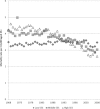Fundamental causes of colorectal cancer mortality: the implications of informational diffusion
- PMID: 22985282
- PMCID: PMC3479384
- DOI: 10.1111/j.1468-0009.2012.00675.x
Fundamental causes of colorectal cancer mortality: the implications of informational diffusion
Abstract
Context: Colorectal cancer is a major cause of mortality in the United States, with 52,857 deaths estimated in 2012. To explore further the social inequalities in colorectal cancer mortality, we used fundamental cause theory to consider the role of societal diffusion of information and socioeconomic status.
Methods: We used the number of deaths from colorectal cancer in U.S. counties between 1968 and 2008. Through geographical mapping, we examined disparities in colorectal cancer mortality as a function of socioeconomic status and the rate of diffusion of information. In addition to providing year-specific trends in colorectal cancer mortality rates, we analyzed these data using negative binomial regression.
Findings: The impact of socioeconomic status (SES) on colorectal cancer mortality is substantial, and its protective impact increases over time. Equally important is the impact of informational diffusion on colorectal cancer mortality over time. However, while the impact of SES remains significant when concurrently considering the role of diffusion of information, the propensity for faster diffusion moderates its effect on colorectal cancer mortality.
Conclusions: The faster diffusion of information reduces both colorectal cancer mortality and inequalities in colorectal cancer mortality, although it was not sufficient to eliminate SES inequalities. These findings have important long-term implications for policymakers looking to reduce social inequalities in colorectal cancer mortality and other, related, preventable diseases.
© 2012 Milbank Memorial Fund.
Figures




Similar articles
-
Fundamental causes of colorectal cancer mortality in the United States: understanding the importance of socioeconomic status in creating inequality in mortality.Am J Public Health. 2013 Jan;103(1):99-104. doi: 10.2105/AJPH.2012.300743. Epub 2012 Nov 15. Am J Public Health. 2013. PMID: 23153135 Free PMC article.
-
A fundamental cause approach to the study of disparities in lung cancer and pancreatic cancer mortality in the United States.Soc Sci Med. 2014 Jan;100:54-61. doi: 10.1016/j.socscimed.2013.10.026. Epub 2013 Nov 1. Soc Sci Med. 2014. PMID: 24444839
-
Fundamental causes of accelerated declines in colorectal cancer mortality: Modeling multiple ways that disadvantage influences mortality risk.Soc Sci Med. 2017 Aug;187:1-10. doi: 10.1016/j.socscimed.2017.06.013. Epub 2017 Jun 13. Soc Sci Med. 2017. PMID: 28645039
-
Social conditions as fundamental causes of health inequalities: theory, evidence, and policy implications.J Health Soc Behav. 2010;51 Suppl:S28-40. doi: 10.1177/0022146510383498. J Health Soc Behav. 2010. PMID: 20943581 Review.
-
Socioeconomic factors and breast carcinoma in multicultural women.Cancer. 2000 Mar 1;88(5 Suppl):1256-64. doi: 10.1002/(sici)1097-0142(20000301)88:5+<1256::aid-cncr13>3.0.co;2-3. Cancer. 2000. PMID: 10705364 Review.
Cited by
-
Barriers and facilitators of colorectal cancer screening using the 5As framework: A systematic review of US studies.Prev Med Rep. 2023 Jul 29;35:102353. doi: 10.1016/j.pmedr.2023.102353. eCollection 2023 Oct. Prev Med Rep. 2023. PMID: 37576848 Free PMC article. Review.
-
Association between ABCB1 (3435C>T) polymorphism and susceptibility of colorectal cancer: A meta-analysis.Medicine (Baltimore). 2020 Feb;99(8):e19189. doi: 10.1097/MD.0000000000019189. Medicine (Baltimore). 2020. PMID: 32080102 Free PMC article.
-
Racial Disparities in Lung Cancer Stage of Diagnosis Among Adults Living in the Southeastern United States.Chest. 2023 May;163(5):1314-1327. doi: 10.1016/j.chest.2022.11.025. Epub 2022 Nov 24. Chest. 2023. PMID: 36435265 Free PMC article.
-
Knowledge and awareness about colorectal cancer and barriers to its screening among a sample of general public in Saudi Arabia.PLoS One. 2023 Aug 23;18(8):e0290269. doi: 10.1371/journal.pone.0290269. eCollection 2023. PLoS One. 2023. PMID: 37611015 Free PMC article.
-
The impact of preventive screening resource distribution on geographic and population-based disparities in colorectal cancer in Mississippi.BMC Res Notes. 2015 Sep 8;8:423. doi: 10.1186/s13104-015-1352-0. BMC Res Notes. 2015. PMID: 26351100 Free PMC article.
References
-
- Alberg AJ, Samet JM. Epidemiology of Lung Cancer. Chest. 2003;123:21S–49S. - PubMed
-
- Baxter NN, Goldwasser MA, Paszat LF, Saskin R, Urbach DR, Rabeneck L. Association of Colonoscopy and Death from Colorectal Cancer. Annals of Internal Medicine. 2009;150:1–8. - PubMed
-
- Boyd C, Zhang-Salomons JY, Groome PA, Mackillop WJ. Associations between Community Income and Cancer Survival in Ontario, Canada, and the United States. Journal of Clinical Oncology. 1999;17:2244–55. - PubMed
-
- Byers T. Two Decades of Declining Cancer Mortality: Progress with Disparity. Annual Review of Public Health. 2010;31:121–32. - PubMed
-
- Carter LE, LaPlant JT. Diffusion of Health Care Policy Innovation in the United States. State & Local Government Review. 1997;29:17–26.
MeSH terms
LinkOut - more resources
Full Text Sources
Medical

